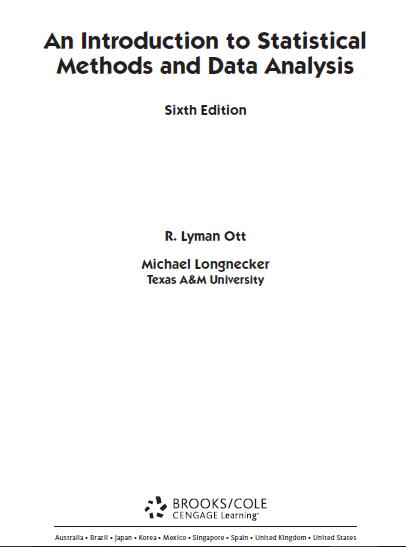
Preface xi
P A R T 1 Introduction 1
CHAPTER 1 Statistics and the Scientific Method 2
1.1 Introduction 2
1.2 Why Study Statistics? 6
1.3 Some Current Applications of Statistics 8
1.4 A Note to the Student 12
1.5 Summary 13
1.6 Exercises 13
P A R T 2 Collecting Data 15
CHAPTER 2 Using Surveys and Experimental Studies
to Gather Data 16
2.1 Introduction and Abstract of Research Study 16
2.2 Observational Studies 18
2.3 Sampling Designs for Surveys 24
2.4 Experimental Studies 30
2.5 Designs for Experimental Studies 35
2.6 Research Study: Exit Polls versus Election Results 46
2.7 Summary 47
2.8 Exercises 48
P A R T 3 Summarizing Data 55
CHAPTER 3 Data Description 56
3.1 Introduction and Abstract of Research Study 56
3.2 Calculators, Computers, and Software Systems 61
3.3 Describing Data on a Single Variable: Graphical Methods 62
3.4 Describing Data on a Single Variable: Measures of Central Tendency 78
3.5 Describing Data on a Single Variable: Measures of Variability 85
3.6 The Boxplot 97
3.7 Summarizing Data from More Than One Variable: Graphs
and Correlation 102
3.8 Research Study: Controlling for Student Background in the
Assessment of Teaching 112
3.9 Summary and Key Formulas 116
3.10 Exercises 117
CHAPTER 4 Probability and Probability Distributions 140
4.1 Introduction and Abstract of Research Study 140
4.2 Finding the Probability of an Event 144
4.3 Basic Event Relations and Probability Laws 146
4.4 Conditional Probability and Independence 149
4.5 Bayes’ Formula 152
4.6 Variables: Discrete and Continuous 155
4.7 Probability Distributions for Discrete Random Variables 157
4.8 Two Discrete Random Variables: The Binomial and the Poisson 158
4.9 Probability Distributions for Continuous Random Variables 168
4.10 A Continuous Probability Distribution: The Normal Distribution 171
4.11 Random Sampling 178
4.12 Sampling Distributions 181
4.13 Normal Approximation to the Binomial 191
4.14 Evaluating Whether or Not a Population Distribution Is Normal 194
4.15 Research Study: Inferences about Performance-Enhancing Drugs
among Athletes 199
4.16 Minitab Instructions 201
4.17 Summary and Key Formulas 203
4.18 Exercises 203
P A R T 4 Analyzing Data, Interpreting the Analyses,
and Communicating Results 221
CHAPTER 5 Inferences about Population Central Values 222
5.1 Introduction and Abstract of Research Study 222
5.2 Estimation of m 225
5.3 Choosing the Sample Size for Estimating m 230
5.4 A Statistical Test for m 232
5.5 Choosing the Sample Size for Testing m 245
vi Contents
5.6 The Level of Significance of a Statistical Test 246
5.7 Inferences about m for a Normal Population, s Unknown 250
5.8 Inferences about m When Population Is Nonnormal and n Is
Small: Bootstrap Methods 259
5.9 Inferences about the Median 265
5.10 Research Study: Percent Calories from Fat 270
5.11 Summary and Key Formulas 273
5.12 Exercises 275
CHAPTER 6 Inferences Comparing Two Population Central Values 290
6.1 Introduction and Abstract of Research Study 290
6.2 Inferences about m1 � m2: Independent Samples 293
6.3 A Nonparametric Alternative: The Wilcoxon Rank Sum Test 305
6.4 Inferences about m1 � m2: Paired Data 314
6.5 A Nonparametric Alternative: The Wilcoxon Signed-Rank Test 319
6.6 Choosing Sample Sizes for Inferences about m1 � m2 323
6.7 Research Study: Effects of Oil Spill on Plant Growth 325
6.8 Summary and Key Formulas 330
6.9 Exercises 333
CHAPTER 7 Inferences about Population Variances 360
7.1 Introduction and Abstract of Research Study 360
7.2 Estimation and Tests for a Population Variance 362
7.3 Estimation and Tests for Comparing Two Population Variances 369
7.4 Tests for Comparing t � 2 Population Variances 376
7.5 Research Study: Evaluation of Method for Detecting E. coli 381
7.6 Summary and Key Formulas 386
7.7 Exercises 387
CHAPTER 8 Inferences about More Than Two Population Central Values 402
8.1 Introduction and Abstract of Research Study 402
8.2 A Statistical Test about More Than Two Population Means: An Analysis
of Variance 405
8.3 The Model for Observations in a Completely Randomized Design 414
8.4 Checking on the AOV Conditions 416
8.5 An Alternative Analysis: Transformations of the Data 421
8.6 A Nonparametric Alternative: The Kruskal–Wallis Test 428
8.7 Research Study: Effect of Timing on the Treatment of Port-Wine
Stains with Lasers 431
8.8 Summary and Key Formulas 436
8.9 Exercises 438
CHAPTER 9 Multiple Comparisons 451
9.1 Introduction and Abstract of Research Study 451
9.2 Linear Contrasts 454
Contents vii
viii Contents
9.3 Which Error Rate Is Controlled? 460
9.4 Fisher’s Least Significant Difference 463
9.5 Tukey’s W Procedure 468
9.6 Student–Newman–Keuls Procedure 471
9.7 Dunnett’s Procedure: Comparison of Treatments to a Control 474
9.8 Scheffé’s S Method 476
9.9 A Nonparametric Multiple-Comparison Procedure 478
9.10 Research Study: Are Interviewers’ Decisions Affected by Different
Handicap Types? 482
9.11 Summary and Key Formulas 488
9.12 Exercises 490
CHAPTER 10 Categorical Data 499
10.1 Introduction and Abstract of Research Study 499
10.2 Inferences about a Population Proportion p 500
10.3 Inferences about the Difference between Two Population
Proportions, p1 � p2 507
10.4 Inferences about Several Proportions: Chi-Square
Goodness-of-Fit Test 513
10.5 Contingency Tables: Tests for Independence and Homogeneity 521
10.6 Measuring Strength of Relation 528
10.7 Odds and Odds Ratios 530
10.8 Combining Sets of 2 � 2 Contingency Tables 535
10.9 Research Study: Does Gender Bias Exist in the Selection of Students
for Vocational Education? 538
10.10 Summary and Key Formulas 545
10.11 Exercises 546
CHAPTER 11 Linear Regression and Correlation 572
11.1 Introduction and Abstract of Research Study 572
11.2 Estimating Model Parameters 581
11.3 Inferences about Regression Parameters 590
11.4 Predicting New y Values Using Regression 594
11.5 Examining Lack of Fit in Linear Regression 598
11.6 The Inverse Regression Problem (Calibration) 605
11.7 Correlation 608
11.8 Research Study: Two Methods for Detecting E. coli 616
11.9 Summary and Key Formulas 621
11.10 Exercises 623
CHAPTER 12 Multiple Regression and the General Linear Model 664
12.1 Introduction and Abstract of Research Study 664
12.2 The General Linear Model 674
12.3 Estimating Multiple Regression Coefficients 675
12.4 Inferences in Multiple Regression 683
12.5 Testing a Subset of Regression Coefficients 691
12.6 Forecasting Using Multiple Regression 695
12.7 Comparing the Slopes of Several Regression Lines 697
12.8 Logistic Regression 701
12.9 Some Multiple Regression Theory (Optional) 708
12.10 Research Study: Evaluation of the Performance of an Electric Drill 715
12.11 Summary and Key Formulas 722
12.12 Exercises 724
CHAPTER 13 Further Regression Topics 763
13.1 Introduction and Abstract of Research Study 763
13.2 Selecting the Variables (Step 1) 764
13.3 Formulating the Model (Step 2) 781
13.4 Checking Model Assumptions (Step 3) 797
13.5 Research Study: Construction Costs for Nuclear Power Plants 817
13.6 Summary and Key Formulas 824
13.7 Exercises 825
CHAPTER 14 Analysis of Variance for Completely Randomized Designs 878
14.1 Introduction and Abstract of Research Study 878
14.2 Completely Randomized Design with a Single Factor 880
14.3 Factorial Treatment Structure 885
14.4 Factorial Treatment Structures with an Unequal Number
of Replications 910
14.5 Estimation of Treatment Differences and Comparisons
of Treatment Means 917
14.6 Determining the Number of Replications 921
14.7 Research Study: Development of a Low-Fat Processed Meat 926
14.8 Summary and Key Formulas 931
14.9 Exercises 932
CHAPTER 15 Analysis of Variance for Blocked Designs 950
15.1 Introduction and Abstract of Research Study 950
15.2 Randomized Complete Block Design 951
15.3 Latin Square Design 963
15.4 Factorial Treatment Structure in a Randomized Complete
Block Design 974
15.5 A Nonparametric Alternative—Friedman’s Test 978
15.6 Research Study: Control of Leatherjackets 982
15.7 Summary and Key Formulas 987
15.8 Exercises 989
CHAPTER 16 The Analysis of Covariance 1009
16.1 Introduction and Abstract of Research Study 1009
16.2 A Completely Randomized Design with One Covariate 1012
16.3 The Extrapolation Problem 1023
16.4 Multiple Covariates and More Complicated Designs 1026
Contents ix
16.5 Research Study: Evaluation of Cool-Season Grasses for Putting Greens 1028
16.6 Summary 1034
16.7 Exercises 1034
CHAPTER 17 Analysis of Variance for Some Fixed-, Random-,
and Mixed-Effects Models 1041
17.1 Introduction and Abstract of Research Study 1041
17.2 A One-Factor Experiment with Random Treatment Effects 1044
17.3 Extensions of Random-Effects Models 1048
17.4 Mixed-Effects Models 1056
17.5 Rules for Obtaining Expected Mean Squares 1060
17.6 Nested Factors 1070
17.7 Research Study: Factors Affecting Pressure Drops Across
Expansion Joints 1075
17.8 Summary 1080
17.9 Exercises 1081
CHAPTER 18 Split-Plot, Repeated Measures, and Crossover Designs 1091
18.1 Introduction and Abstract of Research Study 1091
18.2 Split-Plot Designed Experiments 1095
18.3 Single-Factor Experiments with Repeated Measures 1101
18.4 Two-Factor Experiments with Repeated Measures on
One of the Factors 1105
18.5 Crossover Designs 1112
18.6 Research Study: Effects of Oil Spill on Plant Growth 1120
18.7 Summary 1122
18.8 Exercises 1122
CHAPTER 19 Analysis of Variance for Some Unbalanced Designs 1135
19.1 Introduction and Abstract of Research Study 1135
19.2 A Randomized Block Design with One or More
Missing Observations 1137
19.3 A Latin Square Design with Missing Data 1143
19.4 Balanced Incomplete Block (BIB) Designs 1148
19.5 Research Study: Evaluation of the Consistency of
Property Assessments 1155
19.6 Summary and Key Formulas 1159
19.7 Exercises 1160
Appendix: Statistical Tables 1169
Answers to Selected Exercises 1210
References 1250
Index 1254

